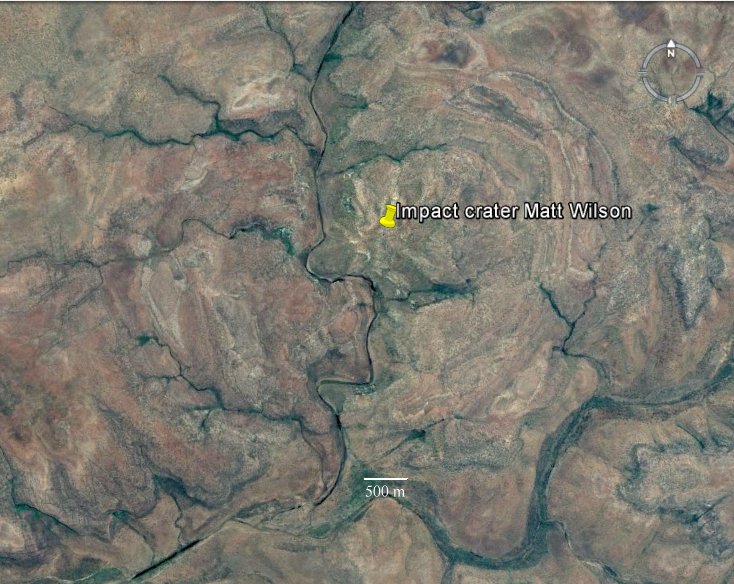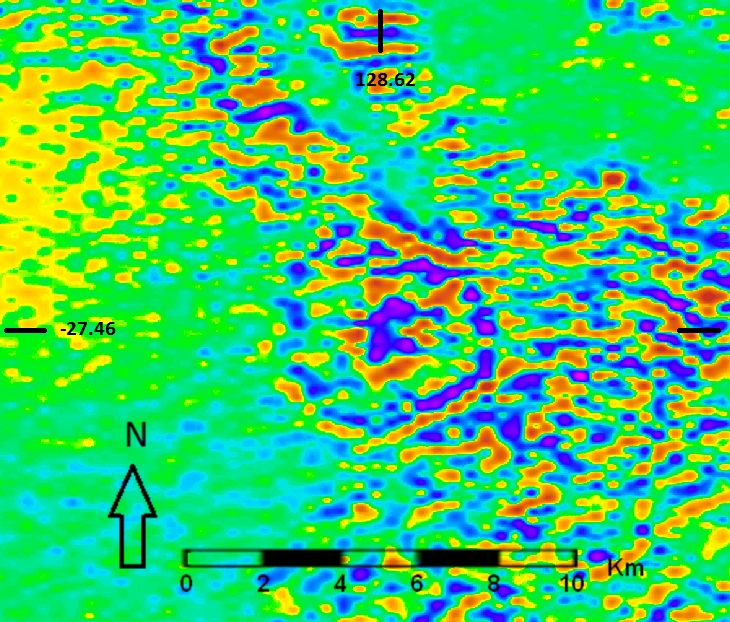
Спутниковая фотография района кратера из Google Earth.

Matt Wilson crater colorized First Vertical Derivative Magnetic map (Klajnik, 2024).
We present results of field analysis, microscopy, and remote sensing mapping of two circular structures in Australia of which the meteorite impact origin is not yet confirmed.
Matt Wilson, Northern Territory (15 30'S; 131 10'50''E): The outline of this possible impact crater is elliptical (4.5 x 6.5 km) with the long axis trending NE-SW. It has been formed in Mesoproterozoic rocks and consists of a crater rim monocline, a ring syncline and a central uplift 1.5 km across. The structure is described in detail by Sweet et al., 2005, who also present microstructures indicative for shock. The central uplift of the structure shows an imbrication of thrust slices in a bilateral arrangement. Such a pattern is
known from other craters like Upheaval Dome or Spider (Scherler et al., 2006). The NE-SW trending symmetry axis is delineated by major faults. The fault pattern, preferred NE strata dipping in the central uplift, and the elliptical crater outline may indicate an oblique impact from NE.
Acknowledgements: We would like to thank DFG for funding this project (KE 732-11/1).
(Kenkmann, Poelchau, 2007).


Matt Wilson crater colorized First Vertical Derivative Magnetic map (Klajnik, 2024).
Строение кольцевой структуры Matt Wilson диаметром 5,5 км, расположенной в бассейне Виктория, Северная Территория, Австралия. Слагающие структуру породы пересечены многочисленными системами трещин, часто имеют волнистые поверхности. Расплавленные породы не обнаружены, но в шлифах песчаника видны зоны интенсивного брекчирования, а в зернах кварца - трещины разнообразных форм. Ударное давление оценено в 5-10 ГПа. Предполагается, что Matt Wilson является сильно эродированной ударной структурой, в которой наиболее измененные ударом породы дна первичного кратера были удалены в процессах эрозии. Ее возраст датируется ранним мезопротерозоем
(Sweet, Haines, Mitchell, 2005).
Стратиграфия, внутреннее строение, микроструктура и деформационные изменения минералов в породах ударного кратера Matt Wilson, Австралия, размером 7.5*6.3 км, образованного телом, упавшим на Землю под углом 10-15'. Перечислены признаки ударного образования кратера, основным из которых является эллиптическая форма структуры.
(Kenkmann, Poelchau, 2009).